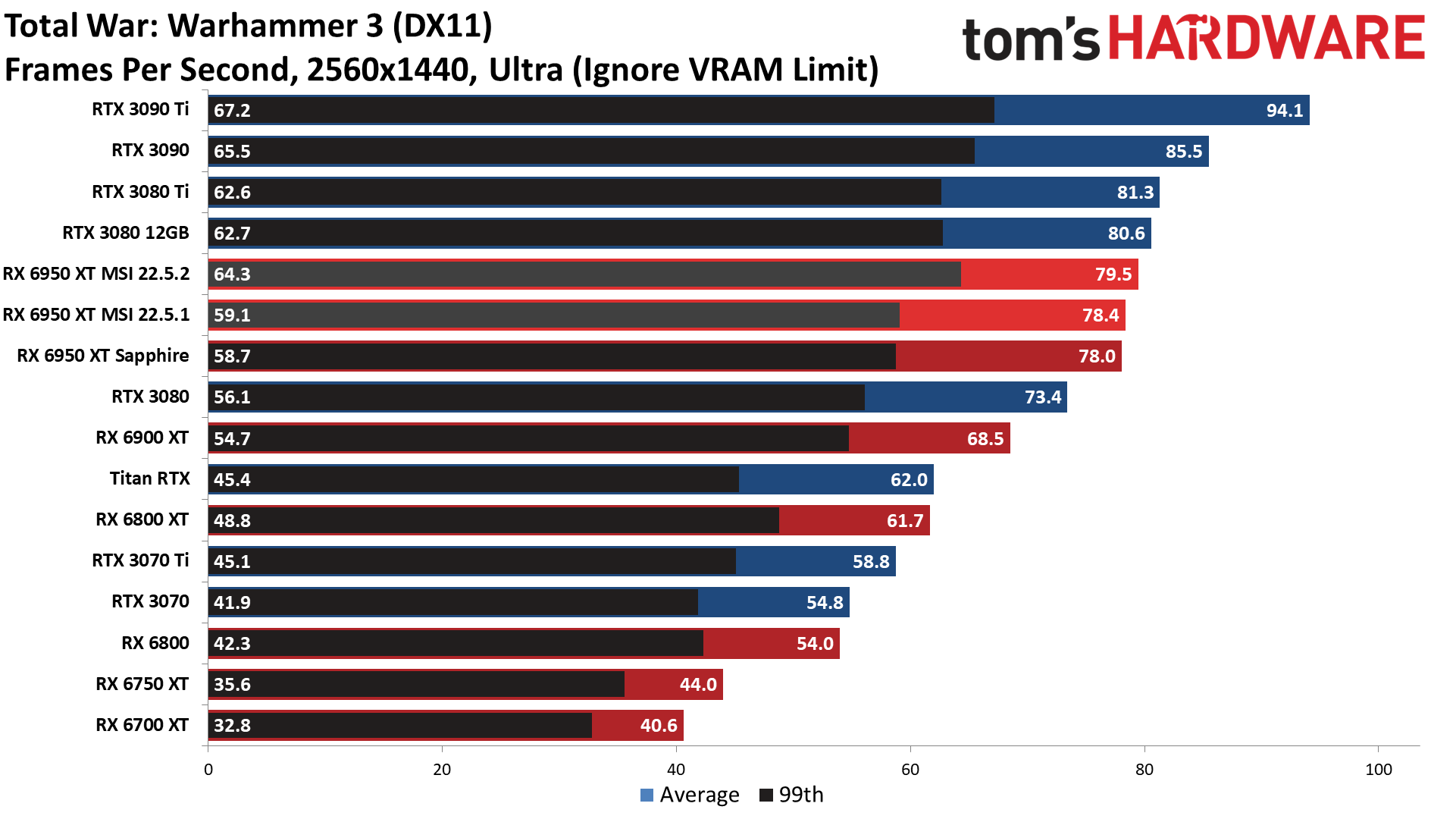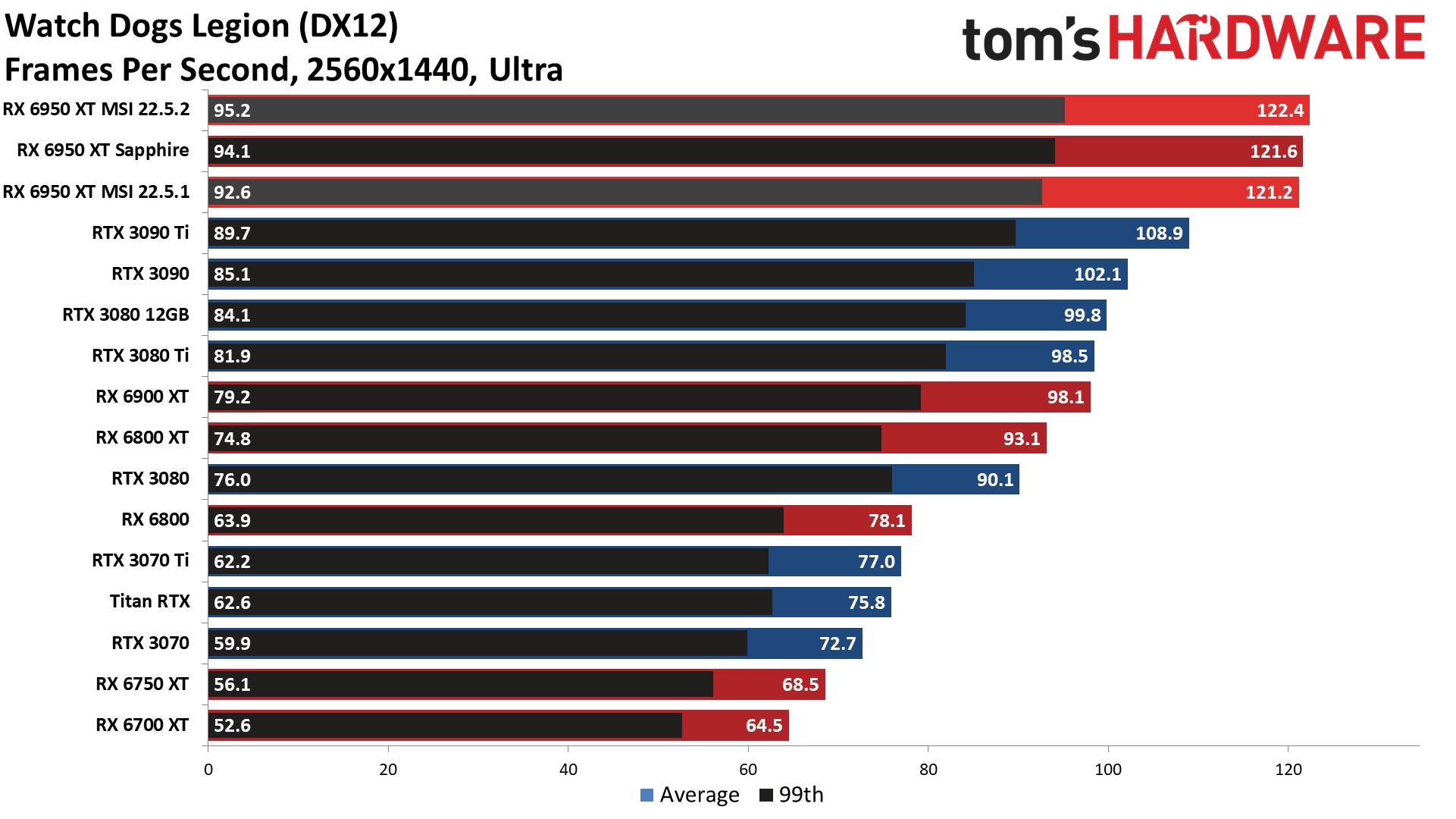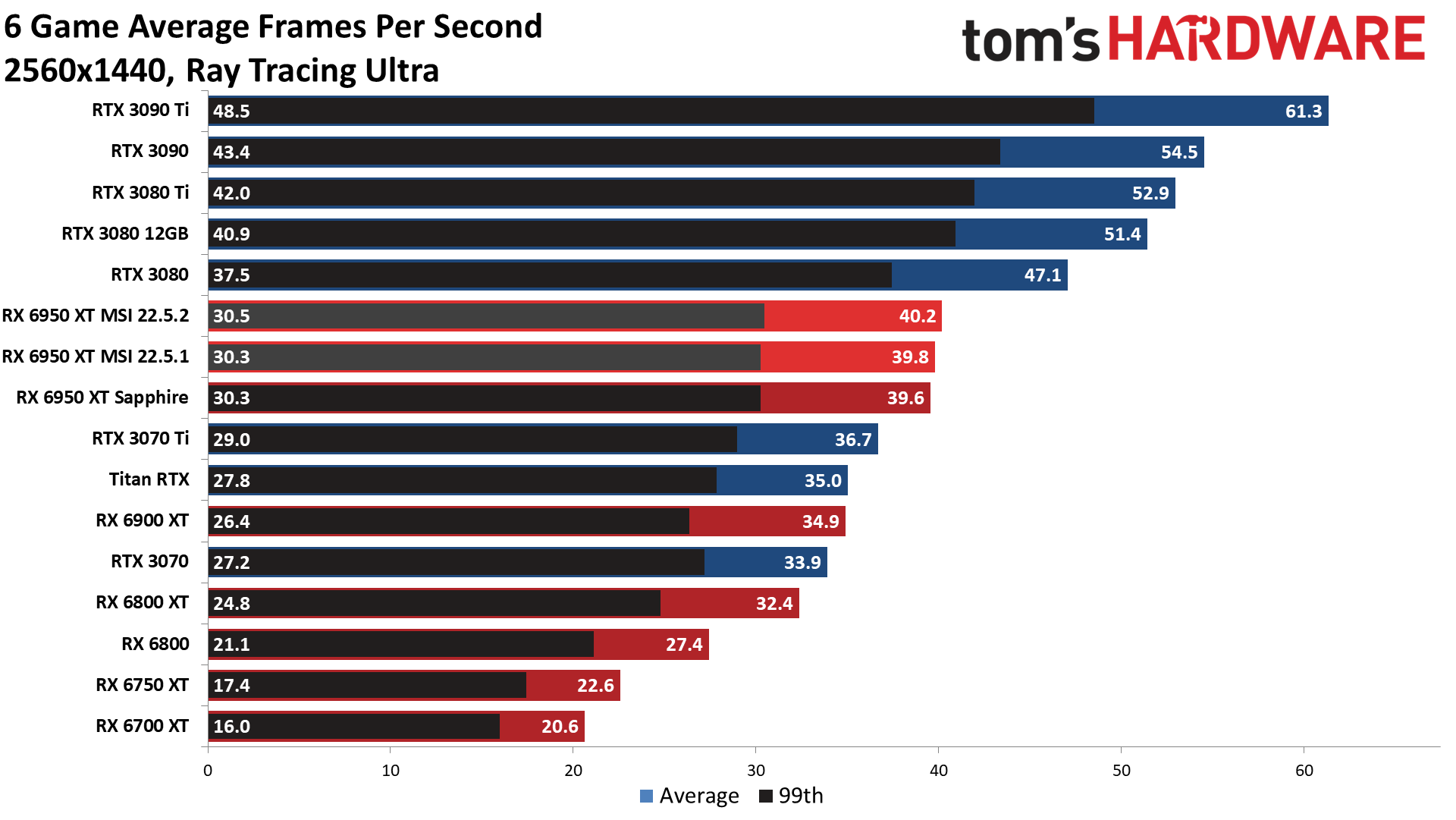Why you can trust Tom's Hardware









While the GPU companies might like to talk about 4K, 1440p ends up being a far better target for most people, especially since high refresh rate 1440p gaming monitors are reasonably affordable. AMD also gets better cache hit rates, with a resulting net 65% boost in performance compared to 4K. Nvidia's RTX 3090 Ti by contrast only got 51% more performance, which allows AMD to claim the overall performance crown at 1440p ultra, beating out the nearest competition by 4%.
Looking at the updated drivers, 22.5.2 still only improved the MSI card's performance by 1.3%. Interestingly, the MSI card was actually slower than the Sapphire card at 1440p when using the same pre-launch 22.5.1 drivers, though not by much (a 0.2% difference).
Turning to the individual game charts, AMD took top honors in five of the eight games, while Nvidia still claimed wins with the RTX 3090 Ti in Flight Simulator, Red Dead Redemption 2, and Total War: Warhammer 3. There's also DLSS support in three of our standard test suite games (Horizon Zero Dawn, Red Dead Redemption 2, and Watch Dogs Legion), and we've measured a 10%–20% improvement with DLSS Quality mode in those. None of the standard test suite games have FSR support, unfortunately, though AMD still gets the overall win at native rendering.







Ray tracing didn't do any favors for AMD, as before, where the MSI card with updated drivers again landed in sixth place. It's ahead of the RTX 3070 Ti and previous generation Titan RTX, but that's about all it could manage. The RTX 3080 was still 17% faster, while the RTX 3090 Ti had a 52% lead. Even if you look at the comparably priced RTX 3080 Ti, that's a 32% advantage, and the RTX 3080 12GB can now be had for under $800 and had a 28% lead.
The MSI RX 6950 XT could at least play all of the games, though Cyberpunk 2077 would still be borderline at 29 fps. It will be interesting to see if AMD puts some serious effort into improved ray tracing hardware and performance with RDNA 3, or if it will continue to cede that segment to Nvidia. Considering the latest gaming consoles have about half the ray tracing capacity as the 6950 XT, there's still an uphill battle in getting game developers to enable higher quality RT effects, but FSR 2.0 and DLSS do help make it more viable.
- MORE: Best Graphics Cards
- MORE: GPU Benchmarks and Hierarchy
- MORE: All Graphics Content
Get Tom's Hardware's best news and in-depth reviews, straight to your inbox.
Current page: MSI Radeon RX 6950 XT: 1440p Gaming Performance
Prev Page MSI Radeon RX 6950 XT: 4K Gaming Performance Next Page MSI Radeon RX 6950 XT: 1080p Gaming Performance
Jarred Walton is a senior editor at Tom's Hardware focusing on everything GPU. He has been working as a tech journalist since 2004, writing for AnandTech, Maximum PC, and PC Gamer. From the first S3 Virge '3D decelerators' to today's GPUs, Jarred keeps up with all the latest graphics trends and is the one to ask about game performance.
-
-Fran- What a terrible model... The Sapphire is way way better, like always. MSI didn't even try to make this card decent; more like just fulfilling commitments or quotas.Reply
Also, I wonder if toying around with the VRAM speed would yield better results than the core in terms of extra FPS'es and specially power for the 6950XT. I have the 6900XT and I know for sure it does, but it's capped at ~2000, since it starts artifacting heavily above that speed for me. I run it stock, but I wanted to test the limit of it, heh.
Regards. -
King_V Editing nipick:Reply
We are not showing professional application performance with the MSI card, as it was basically the same story as we saw with our initial MSI RX 6950 XT content creation results.
That MSI that's linked should say Sapphire.
Still, given how little benefit pushing the extreme limits of power consumption gave to MSI, I'm really curious about how much, or rather, little, performance might be lost in backing down the power and clocks... I know nobody buys a top-of-the-line card in order to be power-efficient, but I wonder if we might have a situation here that is similar to the underclocking runs for the Vega 56. -
JarredWaltonGPU Reply
I poked around a bit at VRAM speeds when I was doing the Sapphire review. Ultimately, I didn't say much about it, but even though you can push clocks higher, I don't think you get the gains that I'd expect. There's something goofy with the VRAM speeds on these 18Gbps modules where you often don't get anywhere near the theoretical boost in performance relative to the existing 16Gbps cards. I suspect memory timings (which you can't directly see on the GDDR6) are somehow at play.-Fran- said:What a terrible model... The Sapphire is way way better, like always. MSI didn't even try to make this card decent; more like just fulfilling commitments or quotas.
Also, I wonder if toying around with the VRAM speed would yield better results than the core in terms of extra FPS'es and specially power for the 6950XT. I have the 6900XT and I know for sure it does, but it's capped at ~2000, since it starts artifacting heavily above that speed for me. I run it stock, but I wanted to test the limit of it, heh.
Regards.
For example, and I know this is a specific use case, but the cryptocurrency mining speed of the RX 6950 XT was consistently far lower than the RX 6900 XT, regardless of what I tried. You can get ~65 MH/s out of the RX 6900 XT after tuning, but the best I ever managed on the RX 6950 XT was about 54 MH/s. "Stock" (factory) performance with a tweak to the maximum GPU clock did better than any attempted memory overclock. -
-Fran- Reply
That is so weirdly interesting... I wonder if the higher clocks were at the expense of way way looser timings?JarredWaltonGPU said:I poked around a bit at VRAM speeds when I was doing the Sapphire review. Ultimately, I didn't say much about it, but even though you can push clocks higher, I don't think you get the gains that I'd expect. There's something goofy with the VRAM speeds on these 18Gbps modules where you often don't get anywhere near the theoretical boost in performance relative to the existing 16Gbps cards. I suspect memory timings (which you can't directly see on the GDDR6) are somehow at play.
For example, and I know this is a specific use case, but the cryptocurrency mining speed of the RX 6950 XT was consistently far lower than the RX 6900 XT, regardless of what I tried. You can get ~65 MH/s out of the RX 6900 XT after tuning, but the best I ever managed on the RX 6950 XT was about 54 MH/s. "Stock" (factory) performance with a tweak to the maximum GPU clock did better than any attempted memory overclock.
Regards. -
Sleepy_Hollowed Wow, what on earth is this card for? Expensive, inefficient space heater?Reply
Since even messing with voltages does not seem to make performance better, this is an absolute head scratcher, probably a spec-hunter card only.
That being said, other versions of this card will get some real usage with AMD's FSR 2.0 and it will make absolute sense even with zero tensor cores. Losing ~7 frames per second to nvidia is neglible at those resolutions and with comparable quality as well.
Let's see if next gen and DLSS 3.0 might be different, but DLSS 2.x is not.